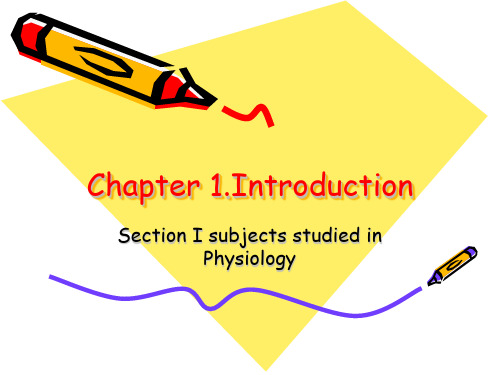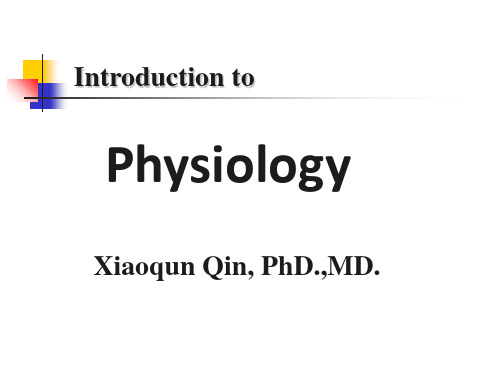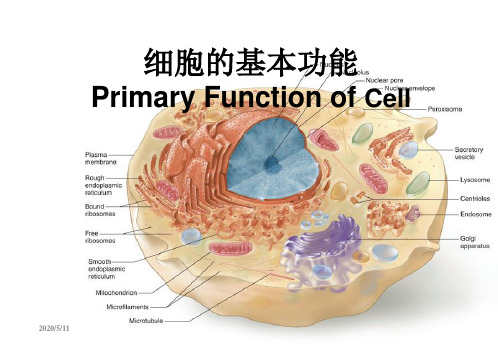生理学英文课件(细胞)Basic Function of the Cell
合集下载
生理学-2细胞2-202

5 细胞质中的 钙离子浓度升高
多种 蛋白 被活化
细胞 效应
6 钙离子激活 其他蛋白质
实例:M1-ACh受体介导的信号转导
三、酶耦联受体介导的信号转导
Signal transduction mediated by receptor-enzymes
酪氨酸激酶受体——受体分子具有酶的活性,即受体与酶 是同一蛋白分子(多种激素、生长因子、细胞因子)
鸟苷酸环化酶受体 ( guanylyl cyclase receptor) 配体 鸟苷酸环化酶(GC)受体
GTP
cGMP
(激活)蛋白激酶G(PKG)
底物蛋白磷酸化
生物效应
五、招募型受体介导的信号转导
胞内部分没有酶活性, 但当胞外域与配体结 合后,胞内域可招募 激酶或转接蛋白,激 活下游信号转导通路
跨膜信号转导
真核细胞内主要的跨膜信息转导途径大致可归 纳为:
离子通道受体介导的信号转导 G蛋白耦联受体介导的信号转导 酶联型受体介导的信号转导 招募型受体介导的信号转导 核受体介导的信号转导
二、离子通道型受体介导的信号转导
Signal transduction mediated by ion channel receptors
信号分子
3. G蛋白效应器(G Protein effector)
酶类:腺苷酸环化酶(AC),磷脂酶C(PLC), 磷酸酶A2(PLA2),磷酸二酯酶(PDE)
通道类
根据效应器种类的不同,G-protein 介导的信号转导途径 主要有以下几种类型: (1) 受体-G蛋白-AC途径 (2)受体-G蛋白-PLC途径 (3) G蛋白-离子通道途径
第二章 细胞的基本功能
Chapter 2. Basic function of the Cells
多种 蛋白 被活化
细胞 效应
6 钙离子激活 其他蛋白质
实例:M1-ACh受体介导的信号转导
三、酶耦联受体介导的信号转导
Signal transduction mediated by receptor-enzymes
酪氨酸激酶受体——受体分子具有酶的活性,即受体与酶 是同一蛋白分子(多种激素、生长因子、细胞因子)
鸟苷酸环化酶受体 ( guanylyl cyclase receptor) 配体 鸟苷酸环化酶(GC)受体
GTP
cGMP
(激活)蛋白激酶G(PKG)
底物蛋白磷酸化
生物效应
五、招募型受体介导的信号转导
胞内部分没有酶活性, 但当胞外域与配体结 合后,胞内域可招募 激酶或转接蛋白,激 活下游信号转导通路
跨膜信号转导
真核细胞内主要的跨膜信息转导途径大致可归 纳为:
离子通道受体介导的信号转导 G蛋白耦联受体介导的信号转导 酶联型受体介导的信号转导 招募型受体介导的信号转导 核受体介导的信号转导
二、离子通道型受体介导的信号转导
Signal transduction mediated by ion channel receptors
信号分子
3. G蛋白效应器(G Protein effector)
酶类:腺苷酸环化酶(AC),磷脂酶C(PLC), 磷酸酶A2(PLA2),磷酸二酯酶(PDE)
通道类
根据效应器种类的不同,G-protein 介导的信号转导途径 主要有以下几种类型: (1) 受体-G蛋白-AC途径 (2)受体-G蛋白-PLC途径 (3) G蛋白-离子通道途径
第二章 细胞的基本功能
Chapter 2. Basic function of the Cells
细胞生理学(1n)

1
(2)主动转运:ATP 由低高转运(逆浓度差)
原发性主动转运 Na +-K+ 泵, Ca2+ 泵, H+泵,有ATP酶活性
继发性主动转运 Na-glucose transportexchanger(逆向转运)
3. Exocytosis and Endocytosis (出胞和入胞)
细胞膜的跨膜物质转运
§3.Signal transduction through the cell membrane
细胞的跨膜信号传递
§ 4.Bioelectricity phenomena of the cell 细胞的生物电现象 §5. Contraction of skeletal muscle 骨骼肌的收缩功能
脂肪酸、类固醇激素、水
水: 渗透(osmosis)
渗透压(osmotic pressure)
8
2.Membrane protein mediated transport
(1)易化扩散:高低转运
经载体(Carrier): 通过构象变化 如: glucose amino acid
特点: a.高度结构特异性, b.饱和现象, c.竞争性抑制, d.顺浓度梯度
•细胞信号传递系统:
各种细胞外信号传导到靶细胞内,启动该细胞生物效应所 涉及的复杂生物系统。 •细胞间的信号传递分为两大类 电传递:细胞兴奋后,通过缝隙连接等结构,以局部电流 的方式,直接诱发相邻细胞活动的过程。 化学传递:通过化学信号物质作用于靶细胞,调节靶细胞 的功能活动的过程。
12
化学传递的方式:
return
36
return
37
膜受体介导入胞是一种 非常有效的转运方式: 溶质可选择性内移, 不需带入较多的ECF。许 多大分子入胞通过此形式: 如结合铁的运铁蛋白, 低密度脂蛋白、胰岛素等
(2)主动转运:ATP 由低高转运(逆浓度差)
原发性主动转运 Na +-K+ 泵, Ca2+ 泵, H+泵,有ATP酶活性
继发性主动转运 Na-glucose transportexchanger(逆向转运)
3. Exocytosis and Endocytosis (出胞和入胞)
细胞膜的跨膜物质转运
§3.Signal transduction through the cell membrane
细胞的跨膜信号传递
§ 4.Bioelectricity phenomena of the cell 细胞的生物电现象 §5. Contraction of skeletal muscle 骨骼肌的收缩功能
脂肪酸、类固醇激素、水
水: 渗透(osmosis)
渗透压(osmotic pressure)
8
2.Membrane protein mediated transport
(1)易化扩散:高低转运
经载体(Carrier): 通过构象变化 如: glucose amino acid
特点: a.高度结构特异性, b.饱和现象, c.竞争性抑制, d.顺浓度梯度
•细胞信号传递系统:
各种细胞外信号传导到靶细胞内,启动该细胞生物效应所 涉及的复杂生物系统。 •细胞间的信号传递分为两大类 电传递:细胞兴奋后,通过缝隙连接等结构,以局部电流 的方式,直接诱发相邻细胞活动的过程。 化学传递:通过化学信号物质作用于靶细胞,调节靶细胞 的功能活动的过程。
12
化学传递的方式:
return
36
return
37
膜受体介导入胞是一种 非常有效的转运方式: 溶质可选择性内移, 不需带入较多的ECF。许 多大分子入胞通过此形式: 如结合铁的运铁蛋白, 低密度脂蛋白、胰岛素等
生理学绪论英文课件

Why must the medical students study human physiology?
• Medical science development is closely related to physiology.
• (1) The classical traditional chinese medicine textbook(内经)presented much knowledge about 经络 and 脏腑 to guide the medical practice.
• Gene levels research
molecular biological methods for molecular level and cell level research
Organ and system levels
• The goals are to explore the effects of organs and systems for human body and how to performe their activities, and the affecting factors.
Cell level research to understand the function of the organ.
• The physiological characteristics of cells depend on the physical and chemical features of the big chemical molecules consisting of the cells.
• molecular level research to study the functions of cells. For instant: myocute contraction
细胞生物学课件英文版-细胞膜

An Overview of Membrane Functions
3.1 An Overview of Membrane Functions (1)
• Compartmentalization – Membranes form continuous sheets that enclose intracellular compartments.
– Channel proteins have hydrophilic cores that form aqueous channels in the membranespanning region.
The Structure and Functions of Membrane Proteins (3)
– Glycoproteins have short, branched carbohydrates for interactions with other cells and structures outside the cell.
– Glycolipids have larger carbohydrate chains that may be cell-to-cell recognition sites.
• Membrane proteins can be grouped into three distinct classes
The Structure and Functions of Membrane Proteins (2)
• Integral Membrane Proteins
– Are amphiphatic, with hydrophic domains anchoring them in the bilayer and hydrophilic regions forming functional domains outside of the bilayer.
生理学课件英文版

It is a dynamic steady state, all of function or regulation in cells or organs contribute to maintain homeostasis. (core theme)
The conception has been now extended to the understanding of all physiological activities constancy.
Internal environment was firstly introduced by Claude Bernard at 1870s. It means the liquid environment in which cells live, that is, extracellular liquid.
Autoregulation: organ or tissue itself directly and
adaptively response to stimulus. character: directly, limited
Positive feedback
command
control
effecter
Regulation for physiological function
Nervous regulation
basic manner: reflex character: rapidly, accurately, momentarily
Humoral regulation
basic manner: hormone, local liquid factors character: slowly, extensively, persistently
The conception has been now extended to the understanding of all physiological activities constancy.
Internal environment was firstly introduced by Claude Bernard at 1870s. It means the liquid environment in which cells live, that is, extracellular liquid.
Autoregulation: organ or tissue itself directly and
adaptively response to stimulus. character: directly, limited
Positive feedback
command
control
effecter
Regulation for physiological function
Nervous regulation
basic manner: reflex character: rapidly, accurately, momentarily
Humoral regulation
basic manner: hormone, local liquid factors character: slowly, extensively, persistently
细胞生理和血液生理学ppt课件

血浆总蛋白质低于60g/L,则可诊断为低蛋白血症。
律。
4
第五章 细胞的基本功能
Basic functions of the cell 第一节 细胞膜的基本结构和物质转运功能
5
一、细胞膜的化学组成和分子结构
Chemical composition and molecular structure of the cell membrane
化学组成: 脂质、蛋白质、糖类等
细胞未受刺激时存在于细胞膜两侧的电 位差。一般为内负外正。
The difference in electrical potential across the membrane of an undisturbed cell, having a positive sign on the outside surface and a negative sign in the interior.
6
7
8
二、细胞膜的跨膜物质转运功能
(一)单纯扩散: 在生物体中,一些脂溶性的小分子物质
顺浓度差的跨膜物质转运。如:CO2,O2 , N2 ,乙醇等。 (二)易化扩散:
不溶于脂质或溶解度甚小的物质,在细胞 膜上一些特殊蛋白质的帮助下,顺浓度差 或电位差的跨膜物质转运。如:葡萄糖, 氨基酸及各种离子等。
机能学概论
首都医科大学 生理学与病理生理学系
傅小锁 Fxs_news163
机能学概论
第一部分:生物化学(Biochemistry) 第二部分:生理学(Physiology)
22
生物化学: 研究生物体内化学活动的过程,在分子
水平探讨生命的本质,研究生物体的分子 组成和功能,探讨物质在体内的代谢过程 及调节。
律。
4
第五章 细胞的基本功能
Basic functions of the cell 第一节 细胞膜的基本结构和物质转运功能
5
一、细胞膜的化学组成和分子结构
Chemical composition and molecular structure of the cell membrane
化学组成: 脂质、蛋白质、糖类等
细胞未受刺激时存在于细胞膜两侧的电 位差。一般为内负外正。
The difference in electrical potential across the membrane of an undisturbed cell, having a positive sign on the outside surface and a negative sign in the interior.
6
7
8
二、细胞膜的跨膜物质转运功能
(一)单纯扩散: 在生物体中,一些脂溶性的小分子物质
顺浓度差的跨膜物质转运。如:CO2,O2 , N2 ,乙醇等。 (二)易化扩散:
不溶于脂质或溶解度甚小的物质,在细胞 膜上一些特殊蛋白质的帮助下,顺浓度差 或电位差的跨膜物质转运。如:葡萄糖, 氨基酸及各种离子等。
机能学概论
首都医科大学 生理学与病理生理学系
傅小锁 Fxs_news163
机能学概论
第一部分:生物化学(Biochemistry) 第二部分:生理学(Physiology)
22
生物化学: 研究生物体内化学活动的过程,在分子
水平探讨生命的本质,研究生物体的分子 组成和功能,探讨物质在体内的代谢过程 及调节。
生理学--细胞 ppt课件

1. Two potassium ions bind on the outside and three sodium ions bind on the inside of the “pump”.
2. The ATPase become activated.
3. An ATP was split to ADP and phosphate, liberating a highenergy phosphate bond of energy.
• “太阳当空照,花儿对我笑,小鸟说早早早……”
第一节 细胞膜的基本结构和跨膜物质转运功能
The Basic Organization and Transporting Function of Cell Membrane
Cell membrane 7.5 to 10 nanometers thick, pliable, elastic
(2)整合蛋白(Integrated Protein):一次或多次贯穿整
个双脂质双分子层(具有疏水性氨基酸构成的片段)。
2. 膜蛋白的功能
(1)跨膜物质转运/Transport (2)受体功能/Receptor (3)酶/Enzyme (4)表面标志/Recognizable part
(三)细胞膜的糖/ Membrane Carbohydrate
① 扩散速率高 (High diffusion rate) ② 无饱和性 (No Saturation ) ③ 不依靠特殊膜蛋白质的“帮助” ④扩散量与浓度梯度、温度和膜通透性呈正相关,
用扩散通量(Flux)表示,其单位是(mol /cm2·s) 。
(3) 转运的物质:
O2、CO2、NH3 、N2 、尿素、乙醚、乙醇、类固醇 类激素 等少数几种。
2. The ATPase become activated.
3. An ATP was split to ADP and phosphate, liberating a highenergy phosphate bond of energy.
• “太阳当空照,花儿对我笑,小鸟说早早早……”
第一节 细胞膜的基本结构和跨膜物质转运功能
The Basic Organization and Transporting Function of Cell Membrane
Cell membrane 7.5 to 10 nanometers thick, pliable, elastic
(2)整合蛋白(Integrated Protein):一次或多次贯穿整
个双脂质双分子层(具有疏水性氨基酸构成的片段)。
2. 膜蛋白的功能
(1)跨膜物质转运/Transport (2)受体功能/Receptor (3)酶/Enzyme (4)表面标志/Recognizable part
(三)细胞膜的糖/ Membrane Carbohydrate
① 扩散速率高 (High diffusion rate) ② 无饱和性 (No Saturation ) ③ 不依靠特殊膜蛋白质的“帮助” ④扩散量与浓度梯度、温度和膜通透性呈正相关,
用扩散通量(Flux)表示,其单位是(mol /cm2·s) 。
(3) 转运的物质:
O2、CO2、NH3 、N2 、尿素、乙醚、乙醇、类固醇 类激素 等少数几种。
2细胞基本生理 ppt课件

3.3 神经干的复合动作电位
• 组成神经干的许多Nf生物电变化的总和。 • 一定范围内,随刺激强度的增加,AP的幅度从无
到有逐渐增大,直至达到一最大幅度 • 随传播距离增加,AP被分解为若干成分。 • 原因:纤维愈粗,阈值愈低,传导速度愈快。
2020/5/11
3.4 神经传导的一般特性
(1) 生理完整性 (2) 传导的绝缘性
2020/5/11
阈电位:RP去电极达到某一临界数值,引起Na+通 道大量开放,Na+大量内流而爆发AP。 电压门控通道
2020/H5/11odgkin循环
锋电位:神经冲动的表现形式,幅度为RP与超射之和
后电位:锋电位之后
的微小电位波动;
相
包括负后电位和正
对
后电位。
不 应超
期常
期
2020/5/11
• 关闭(备用) 激活
失活
•
细胞膜电势变化
备用
2020/5/11
Stretch
机械门控式通道
MechanicCalolsleyd -gated
Open
2020/5/11
2020/5/11
(2) 主动转运
钠泵
(Na-K-ATP酶), 每分解1分子ATP, 排出3个Na+,摄入2 个K+。
斯科(Jens C.Skou),
• c. 收缩性 肌肉组织的特性 • 速度快、强度大、但不能持久。
2020/5/11
4.3.2 肌肉收缩的机械变化
• a. 等张收缩和等长收缩
2020/5/11
• b.单收缩 Single Twitch : 实验条件下,肌肉受到单 个有效刺激而产生一次迅 速而短暂的收缩
- 1、下载文档前请自行甄别文档内容的完整性,平台不提供额外的编辑、内容补充、找答案等附加服务。
- 2、"仅部分预览"的文档,不可在线预览部分如存在完整性等问题,可反馈申请退款(可完整预览的文档不适用该条件!)。
- 3、如文档侵犯您的权益,请联系客服反馈,我们会尽快为您处理(人工客服工作时间:9:00-18:30)。
1) Extrinsic protein (peripheral protein) To attach only to one surface of the membrane, and do not penetrate. Function: almost entirely as enzyme
Intrinsic protein (integral protein)
cell
Mitochondria : provide energy, ATP
Endoplasmic reticulum
rough endoplasmic reticulum: contains ribosome (核蛋白体) related to protein synthesis
smooth endoplasmic reticulum related to production of lipid and glucose
② diffusion is a passive process, needn’t energy
③the rate of diffusion is determined by the concentration difference (concentration gradient), the velocity of kinetic motion, the number and size of openings in the cell membrane through which the molecules or ions can move, by the potential difference for ions ④ the time for diffusion is direct proportion to square of diffusion distance
Facilitated diffusion (易化扩散)
carrier – mediated diffusion need a specific carrier protein helping it to do so
Characteristic of facilitated diffusion
These differences are important to the life of the cell <1> Chemical components and Molecular structure of the Cell Membrane
(1) Fluid- mosaic Model The cell membrane and membranes of organelles are composed of Lipids and proteins: Protein : Lipid = 4:1 – 1:4 Depending on the functional activities of membranes
Transport of substances through the membrane
Passive transport (被动转运)
All molecules and ions in the body fluid are in constant motion. The greater the motion is, the higher the temperature will become.
To penetrate all the way through membrane
Function: ① provide structural channels for water molecules, water-soluble substances especially ions; ② act as carrier proteins for transporting substances not penetrating the lipid bilayer; ③ act as enzymes
Extracellular fluid Na+ K+ ClPhosphates 142 mEg/L 4 mEg/L 103 mEg/L 4 mEg/L Intracellular fluid 10 mEg/L 140 mEg/L 4 mEg/L 75 mEg/L
Proteins
5 mEg/L
40 mEg/L
Occur almost in combination with proteins or lipids to form glycoproteins or glycolipids. The carbohydrate moieties attached to the outer surface of the cell have following functions:
Functions of membrane proteins
① structural elements (commisure protein)
② enzyme ③ receptor ④ transporter: channel and carrier
Membrane carbohydrates
A simple physic diffusion without the necessity of bind with carrier proteins in the membrane.
Characteristics of simple diffusion
① Only fat-soluble substances (O2 CO2 NO etc.) can diffuse through the lipid bilayer in the membrane
Compositions of lipids of cell membrane
Phospholipid > 70% Cholesterol < 30% Sphingolipid glyclipid
Membrane proteins
A. Types of membrane proteins
Compositions of cell membrane:
Protein 55% Other lipids 4% Phospholipid 25% Carbohydrates 3% Chlesterol 13%
Lipid barrier of the cell membrane prevents water penetration
Diffusion depends on concentration difference and potential difference, without the necessity of supplying energy, called passive transport.
Simply diffusion
Hale Waihona Puke Fluid mosaic model
1972, Singer and Nicholson Main point: a lipid bilay as the frame of cell membrane; Interspersed in a lipid bilayer are larger globular protein molecules.
Golgi apparatus (高尔基体)
Lysome (溶酶体): digest aging or damage structures Microtuble(微管)
The components of cytoplasma: Water: 80% Protein: 14% Lipid: 2% Others: 4%
a lipid bilayer
1890, Overton, cell membranes have higher permeability to fatty – soluble substances. Suggesting : cell membrane is composed of lipid. 1925, Gorter and Grender Based on the experimental results about area of the red blood cells, believed the membrane Lipids were arranged in a bilayer manner
Review the basic structure of Cell
Cell membrane protoplasm :water etc. cytoplasma Organelle: Mitochondria etc. Nuclear membrane Neucleus Neucleolus : Contain RNA, DNA
The molecules move concentration to low one.
from
higher
This continual movement of molecule among one another in liquid, or in gases, is called diffusion.
Chapter 2.
Basic Function of the Cell
2012年9月2日星期日
There are about 100 trillion (万亿) cells in a human being ( red blood cells about 25 trillion).
Each of 100 trillion is a living structure that can survive and reproduce itself. If to understand the function of organs and other structures of the body, it is essential that we first understand the basic organization of the cell and the function of its component parts.
